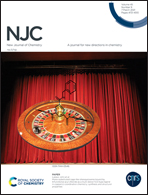Theoretical insight into the CdS/FAPbI3 heterostructure: a promising visible-light absorber
Abstract
Metal halide perovskites have drawn considerable attention thanks to their excellent optoelectronic performances. However, further development has been severely hampered by their poor stability. Recently, it has been confirmed experimentally that the optical performance of perovskites is significantly improved by the incorporation of a CdS layer. Based on this, first-principles calculations are conducted to probe the inherent mechanism, including the electronic structure, absorption spectra, strain effect, etc. The optimized geometric structure shows that the distance between the CdS layer and the FAPbI3 layer is smaller than 3.0 Å, which implies that the CdS/FAPbI3 heterostructure is more stable than common van der Waals heterostructures. Moreover, it is revealed that the electronic states at the band gap edge are from different component layers. It is further unveiled by Bader charge analysis that the electronic charge is transferred from the FAPbI3 layer to the CdS layer, which is consistent with the charge density difference (CDD). In addition, the absorption coefficient in the CdS/FAPbI3 heterostructure is remarkably enhanced, compared with that of pure perovskite FAPbI3. Furthermore, the strain effect on the bandgap of the CdS/FAPbI3 is also explored. These results shed new light on understanding and designing new kinds of highly efficient perovskite-based photovoltaic materials.



 Please wait while we load your content...
Please wait while we load your content...